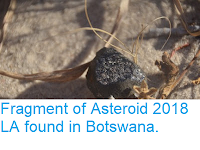Residents of the town of Viñales in western Cuba have reported finding fragments of what appear to be a meteorite after hearing what sounded like a loud sonic boom on Friday 1 February 2019. The boom was heard slightly after 1.20 pm local time, and coincided the detection of an unknown object by the US National Weather Service Radar Station at Key West in Florida. The American Meteor Society has
received reports of a bright fireball meteor being seen off the southwest coast of Florida. Reports from Cuba report numerous black stones, some as large as the palm of an adult's hand, being found in and around Viñales after the event.
Fragment of rock believed to be a meteorite found in the Cuban town of Viñales on Friday 1 February 2019. Rolando Segura/Twitter.
A fireball
is defined
as a meteor
(shooting star) brighter than the
planet Venus. These are typically caused by pieces of rock burning up in
the atmosphere, but can be the result of man-made space-junk burning up
on re-entry. This object appeared to move northeast-to-southwest.
Map
showing areas where sightings of the meteor were reported, and the
apparent path of the object (blue arrow). American Meteor Society.
Objects
of this size probably enter the Earth's atmosphere several times a
year, though unless they do so over populated areas they are unlikely to
be noticed. They are officially described as fireballs if they produce a
light brighter than the planet Venus. The brightness of a meteor is caused by friction with
the Earth's atmosphere, which is typically far greater than that caused
by simple falling, due to the initial trajectory of the object. Such
objects typically eventually explode in an airburst called by the
friction, causing them to vanish as an luminous object. However this is
not the end of the story as such explosions result in the production of a
number of smaller objects, which fall to the ground under the influence
of gravity (which does not cause the luminescence associated with
friction-induced heating).
'Smoke trail' caused by the 1 February 2019 meteor, made up of material ablated from the object's surface by friction with the atmosphere. Juan Aberto Pérez Pozo/Youtube.
These 'dark objects' do not continue along the path
of the original bolide, but neither do they fall directly to the ground,
but rather follow a course determined by the atmospheric currents
(winds) through which the objects pass. Scientists are able to calculate potential trajectories for hypothetical dark
objects derived from meteors using data from weather monitoring services.
Fragment of rock believed to be a meteorite found in the Cuban town of Viñales on Friday 1 February 2019. Hatzel Vela/Twitter.
Witness reports can help astronomers to understand these events. If you
witness a fireball-type meteor over the US you can report it to the American Meteor Society here.
Object detected at an altitude of 8000 m above the town of Viñales in western Cuba by the US National Weather Service Radar Station at Key West in Florida, at 1.21 pm on Friday 1 February 2019. National Weather Service Key West/Twitter.
See also...
Follow Sciency Thoughts on Facebook.











